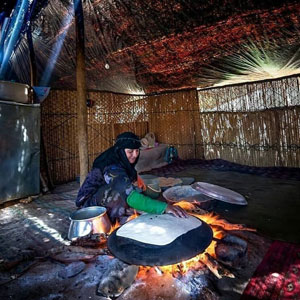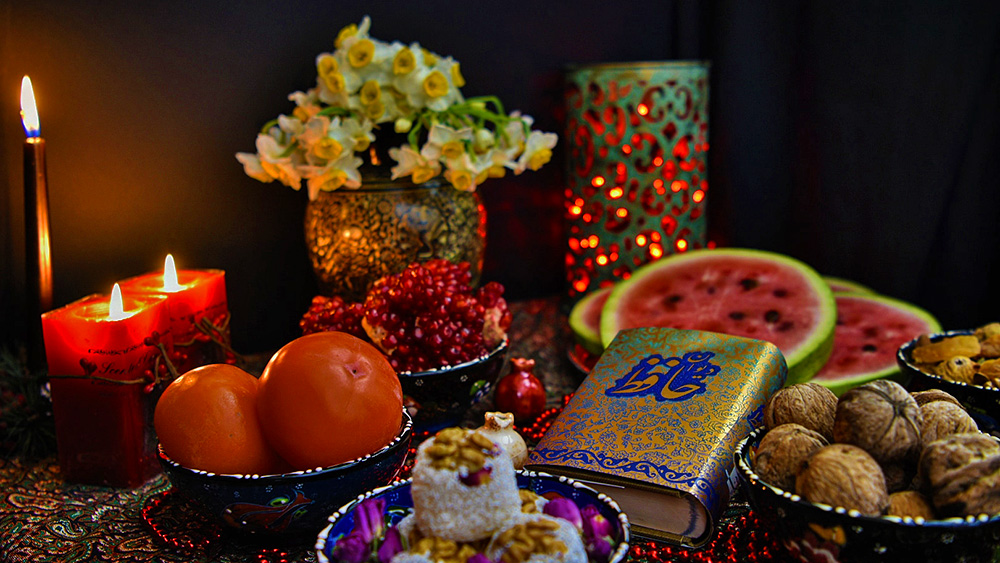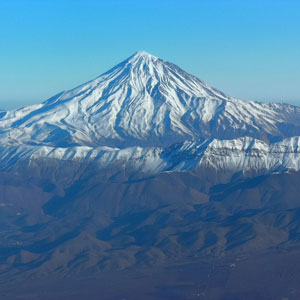 Signin with Google
Signin with Google Signin with Facebook
Signin with Facebook
 Activities,Culture
Activities,CultureYalda, the Longest Night of the Year

It’s been a few thousand years since Iranians are celebrating Yalda night in friendly and family-based gatherings. Shab-e Yalda is the last night of autumn, the longest and darkest night of the year; It is also a point when the days begin to stretch in the northern hemisphere and Yalda is a winter solstice celebration so it refers also to Shab-e Chelleh, the night of forty. In ancient times people considered winter to consist of two parts, each part took 40 nights long, Shab-e Chelleh was the beginning of the big Chelleh which was actual winter. Yalda Night is celebrated between the sunset of the last day of autumn and the sunrise of the first day of winter. In ancient Persian legacy, “Yalda” is not just a festival, but it is also a symbol of brightness and light. It is a big reason that gets all family members, friends and relatives to gather together and create happy and joyful moments all throughout the night. In order for this ancient celebration to be preserved and promoted widely, in 2009 Yalda night, with nearly eight thousand years of antiquity, was documented as an Iranian Spiritual Heritage.
Rebirth of the Sun
The word “Yalda” means “birth” and “birthday”. Ancient Iranians believed that on the day after Yalda Night, when the sun rises on the first day of winter, the days start to stretch and the sunlight begins to lengthen; They called the end of autumn and the beginning of winter “The sun’s birthday, the advent of Mithra the goddess of light and they widely celebrated it. Therefore, According to the solar calendar, they named the tenth month of the year “Dey”, which is the rebirth-month of the Sun.
Yalda’s History
Yalda Night celebration is an ancient tradition. In the past people who lived by farming and agricultural activities, gradually realized that it would be a great idea to set their routine works and living activities based on the Sun’s rotation and seasonal changes; In fact, with their own experiences they figured out that in some seasons, days become very long. They came to the realization that they could make complete use of Sunlight and longer daylight in carrying their activities, to their own benefit. During ancient times, Iranians discovered the fact that the last day of autumn is the shortest day of the year, and immediately afterwards, the upcoming days will gradually become longer in length. In a way that they named the longest night of the year the “Sun’s birth-night” which reminds us of the victory of brightness (Goodness) over darkness (Demon/Ahriman). Subsequently, the belief in which it refers to the Sunlight and brightness as a symbol of goodness and to the darkness of the Night as a symbol of oppression and demon came into existence; and there is still a constant conflict between them.
How does Yalda Table look like?
In every city of Iran, Yalda Night’s table is set in accordance with the local fruits and meals of that city; however, special nuts, watermelon, pomegranate and sweets which are the symbols of blessing, health, wellness and happiness, are common members of Yalda night table setting, all throughout Iran. Watermelon and pomegranate represent the Sun because of their red colours. Special nuts with nutritious characteristics served during the Yalda Night are supposed to entertain the guests during the party. Drinking tea and having various local sweetmeats will surely strengthen the joyfulness of this celebration.
The components of Yalda night, grace and epic
Alongside all these delicious meals, Divan-e-Hafez and Shahnameh are dominant members of this table. Divan-e-Hafez is a precious collection of poems in Farsi, composed by the most popular Persian poet, known as Hafez. Hafez’s poems are considered to be sacred to most of the Iranian people, and at Yalda Night, they usually use Divan-e-Hafez for fortune telling which is called “Faal-e-Hafez”. During this divination process, before anything else people make a heart wish, then they open Divan-e-Hafez book on a very random page, read the poem of that page and interpret its meaning. They believe that this poem can be used as a foreteller.
Shahnameh (Book of kings) is a precious collection of ancient myths and legends of Iran composed by Ferdowsi. Ferdowsi is globally regarded as one of the greatest and most prominent epic poets.
Yalda Night Rite
A few days before Yalda Night, you can feel a special atmosphere in each city and even in the small villages of Iran; streets are more crowded; and you can find a large number of people buying fruits and nuts in shopping centres, preparing themselves to celebrate this night in the best and most beautiful way possible. Since long times ago, families gather around warm Korsis, reading poems and telling stories all throughout Yalda Night. “Korsi” is a short height square-shaped table, with a heater in its inner central part warming legs and body during the cold nights. The surface of Korsi is completely covered with a big blanket decorated with traditional rugs called “Jajim” or coverlets such as Cashmere (Termeh cloth), to prevent warm air wasting. A copper tray is put on the table in accordance with the size of the Korsi. A lantern/lamp, a Samovar (a metal container traditionally used to heat water for tea preparation which is originally from Russia), fruits, nuts and other meals are all put on that copper tray. This will undoubtedly make for the best opportunity to experience a warm and friendly gathering.
On this night, the elderly of the families often narrate stories, read Shahnameh and use Divan-e-Hafez for fortune-telling. Although Yalda Night is held in such simple and traditional ways, some specific customs and traditions are performed at Yalda Night in some cities of Iran. Iranians are not the only people who celebrate the longest night of the year, but some other countries neighbouring Iran, such as Afghanistan, Pakistan and Tajikistan also celebrate this night.
By Sara Kheirdoust / TasteIran



